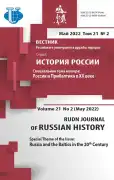Cadres Issue in the Post-war Baltic Republics: Characteristics and Solution
- 作者: Boldovskiy K.A.1, Pivovarov N.Y.2,3
-
隶属关系:
- St. Petersburg Institute of History of Russian Academy of Sciences
- First Moscow State Medical University (Sechenov University)
- Institute of World History of Russian Academy of Sciences
- 期: 卷 21, 编号 2 (2022): Russia and the Baltics in the 20th Century
- 页面: 190-203
- 栏目: RUSSIA AND THE BALTICS IN THE 20TH CENTURY
- URL: https://journal-vniispk.ru/2312-8674/article/view/321995
- DOI: https://doi.org/10.22363/2312-8674-2022-21-2-190-203
- ID: 321995
如何引用文章
详细
The article analyzes the main qualitative characteristics and features of the leadership and specialists’ formation of Latvia, Lithuania and Estonia in the period of “late Stalinism.” The main sources for the article were the archival documents of the thematic cases of the Politburo of the Central Committee of the All-Union Communist Party of the Bolsheviks and the materials of the “Survey of executives and specialists as of November 1, 1947” - a unique closed census, the results of which were reported only to the top Soviet leadership. The article analyzes the total number of employees in specific industries, the proportion of the workers of the “indigenous” nationality and the number of managers who came to work to the republics after the end of the war. The latter data are of particular importance, since they made it possible to calculate the proportion of workers in certain industries who lived in the republics during the occupation. Special attention is paid to the management system and political campaigns that exerted direct influence on cadres policy. The analysis carried out by the authors showed that the proportion of leaders and specialists of “indigenous nationalities” did not exceed 85 %, and most often was 50-60 %. At the same time, at the level of uyezds and volosts, the proportion of “indigenous” nationalities increased to 95 %, i.e. at the grassroots level, most of the leaders and professionals were local residents, usually non-members, who had spent the war years under the occupation. Probably, this circumstance caused concern of the central authorities and led to a number of political campaigns in the late 1940s - early 1950s. Only after J.V. Stalin’s death did the reform of cadres policy begin; L.P. Beria and N.S. Khrushchev can be considered its authors.
作者简介
Kirill Boldovskiy
St. Petersburg Institute of History of Russian Academy of Sciences
Email: bold63@mail.ru
ORCID iD: 0000-0002-7152-9484
PhD in History, Senior Research Fellow
7, Petrozavodskaya ul., St. Petersburg, 197110, RussiaNikita Pivovarov
First Moscow State Medical University (Sechenov University); Institute of World History of Russian Academy of Sciences
编辑信件的主要联系方式.
Email: pivovarov.hist@gmail.com
ORCID iD: 0000-0002-5225-7524
PhD in History, Associate Professor, First Moscow State Medical University (Sechenov University); Chief Researcher, Institute of World History of History of Russian Academy of Sciences; Institute of World History of History of Russian Academy of Sciences
8, Trubetskaya St., Moscow, 119991, Russia; 32a, Leninskiy Av., Moscow, 119334, Russia参考
- Boldovskiy, K.A. “Sotsial'nyi sostav rukovoditelei poslevoennogo Leningrada po dannym ucheta 1947 g.” Modern History of Russia, no. 3 (2012): 197-213 (in Russian).
- Demet'ev, I.O. “Politika pamiati v Klaypede na rubezhe 1940-1950-kh godov (po materialam gazety ‘Sovetskaya Klaypeda’).” Vestnik Baltiyskogo federal'nogo universiteta im. I. Kanta. Ser.: Gumanitarnye i obshchestvennye nauki, no. 4 (2016): 93-108 (in Russian).
- Feest, D. Zwangskollcktivierung im Baltikum. Koln und Wien: Böhlau, 2007 (in German).
- Hämäläinen, M. “Eestimaa Kommunistliku Partei Keskkomitee nomen klatuur 1945-1990: areng ja statistika.” Ajalooline Ajakiri, no. 4 (2015): 357-386 (in Estonian).
- Khodjakov, M.V. “Materialy gosudarstvennogo arhiva Estonii kak istochnik po izucheniyu istorii voennoplennykh vtoroi mirovoi voiny v lageriakh NKVD-MVD ESSR. 1944-1949 gg.” Herald of an Archivist, no. 2 (2013): 121-132 (in Russian).
- Khodjakov, M.V. “Partiino-sovetskoe rukovodstvo Estonskoi SSR i bor'ba za trudovye resursy lagerei NKVD dlia inostrannykh voennoplennykh v 1944-1946 gg.” Trudy istoricheskogo fakul'teta Sankt-Peterburgskogo universiteta, no. 21 (2015): 272-282 (in Russian).
- Laukajtite, R. “Sovetskie i natsional'nye tsennosti v poslevoennoi Litve: rychagi indoktrinatsii obshchestva, 1944-1953 gg.” In Sovetskoe gosudarstvo i obshchestvo v period pozdnego stalinizma. 1945-1953 gg. Moskow: ROSSPEN Publ., 2015: 164-171 (in Russian).
- Liivik, O. “Nomenklatuurisüsteemi funktsioneerimisest aastatel 1944-1953 Eesti NSV valitsusliikmete näite.” Ajalooline Ajakiri, no. 4 (2015): 387-406 (in Estonian).
- Maksimenkov, L. “Priznaniia lubianskogo marshala. Neizvestnyy memorandum Lavrentiya Beriya o polozhenii v Litve v 1953 g.” Nezavisimaya gazeta, no. 162 (2005) (in Russian).
- Mertelsmann, O. Der stalinistische Umbau in Estland. Von der Markt zur Kommandowirtschaft. Hambur: Kovač, 2006 (in German).
- Mertelsmann, O. Die Sowjetisierung Estlands und seiner Gesellschaft. Hambur: Kovač, 2012 (in German).
- Mertelsmann, O., Rahi-Tamm, A. “Cleansing and compromise. The Estonian SSR in 1944-1945.” Cahiers du Monde Russe, no. 49 (2008): 319-340.
- O’Sullivan, D. “Reconstruction and Repression - the role of M. Suslov in Lithuania, 1944-1946.” In Forum für Osteuropäische Ideen und Zeitgeschichte, no. 1 (2000): 195-208 (in German).
- Saueauk, M. “Erikaader: nomenklatuur ja julgeolekuorganid Eesti NSV-s 1940-1953.” Ajalooline Ajakiri, no. 4 (2015): 407-440 (in Estonian).
- Tammela, H. Eesti NSV nomenklatuur (1944-1953). Bakalaureusetöö. Juhendaja. Tartu: Ülikool, 2005 (in Estonian).
- Tannberg, T. Politika Moskvy v respublikakh Baltii v poslevoennye gody (1944-1956). Issledovaniya i dokumenty. Moscow: ROSSPEN, 2010 (in Russian).
- Tininis, V. Political Bodies of the Soviet Union in Lithuania and their Criminal Activities: the second soviet occupation (1944-1953). Vilnus: Margi Rastai, 2008.
- Zubkova, E.Yu. “Fenomen ‘mestnogo natsionalizma’: ‘Estonskoe delo’ 1949-1952 godov v kontekste sovetizatsii Baltii.” Otechestvennaya istoriya, no. 3 (2001): 89-102 (in Russian).
- Zubkova, E.Yu. “Tsentr i baltiiskie Respubliki: ‘perezagruzka’ vzaimootnoshenii v 1950-e gg.” Ural'skij Istoricheskij Vestnik, no. 2 (2019): 112-119 (in Russian).
- Zubkova, E.Yu. Pribaltika i Kreml'. 1940-1953. Moscow: ROSSPEN, 2008 (in Russian).
补充文件









